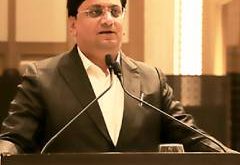Clover Infotech, a technology service provider founded in 1994 by Javed Tapia, one of the founders of the open source revolution in India, is a Platinum partner of Oracle and Gold partner of Microsoft, with partnerships with SAP, IBM, SAS, and Splunk etc. In the dynamic enterprise scenario, they see more traction in the market in developing and maintaining applications, engagement platforms and services such as mobility, apps and portals (for both, internal and external stakeholders). With user engagement services that include social interaction offerings on WebCenter, Liferay, etc. and mobility-based solutions, it is clear that organizations are now realizing the potential and necessity of digital transformation, says Mr. Vijay Talele, Director, Delivery, Clover Infotech.
1. Clover offers in-house Application solutions. Which areas do you see the most traction in the market?
We are one of the leading technology service providers and cater to an extensive clientele across sectors. But, the banking and financial sector companies account for a major part of our business. We offer a combination of technology and domain expertise. With our expertise in latest digital technologies and leveraging analytics, we help organizations design their digital roadmap and implement it efficiently.
2. What do you see as the future for open source technology apps?
Companies today have become increasingly focused on digitization. The open source technology apps have laid the foundation for the SMAC (Social, Mobile, Analytics and Cloud) revolution. The focus would be more on enhancing core kernel, while providing subscription-based support that could be a readily accepted trend, soon. NGINX, which is based on Apache Web Server and similar technologies, will be seen leading the open source technology applications landscape in the near future.
3. With the cloud taking over a large number of operational functions in any enterprise, how do you see data center technologies changing to survive?
The changing business landscape demands for smarter technological adaptations and acceptance of cloud technology, which would turn out to be a key business driver. Organizations have already accepted SaaS and are now exploring the benefits of PaaS and IaaS. Reducing CAPEX has become a focus area for organizations and in order to achieve it, they are now more inclined towards making data center technologies leaner and adopting the ‘pay-per-use’ mechanism. Enabled by cloud technology, Public Data Center (IDC) would aim to transform the services and provide an in-house hosting experience. Private data centers shall continue to exist as long as they transform themselves with the changing technologies, but the magnitude will continue to diminish as organizations implement private cloud, virtualization and consolidation strategies. Also, hybrid data centers are rapidly becoming a favorable option for organizations.
4. Which areas do you want to focus for growth, with your insights into the technologies of the future?
The future of technology clearly lies in harnessing and leveraging the power of integrating the non-digital devices into the digital ecosystem, and also the smart devices and web. Smart devices, IOT (Internet of Things), artificial intelligence and SMAC are the game changers of tomorrow, and hence, our areas of focus. While we are rapidly growing in the fields of analytics and honing our expertise in cloud computing, success lies in integrating all of these and making businesses smarter.
5. Managed services seem to be the goal of the service industry. Is Clover headed there too?
We have already been providing end-to-end Managed Services to some of the leading companies in the BFSI sector for years now. We provide best-in-class Infrastructure and Application Management services to optimize cost and improve business efficiency – enhance ROI, mitigate risks, ensure high availability and meet SLAs. We are also focusing on enabling technology transformation, while we continue to provide managed services.
6. The IT infrastructure scene has changed unrecognizably due to storage and apps transformations at various levels. What future do you see for enterprise applications on the cloud? In short, beyond the cloud, where?
While globally the cloud has had enterprise presence for more than 5 years now, in India, most enterprises started taking it seriously only about 3 years ago. Industries and enterprises are still in an exploratory mode. They have not made up their mind about it utilizing its vast power to support enterprise end –to- end. A lot of IT services can be delivered on the cloud. As I see it, in two or three years’ time, one cloud service provider would be able to collaborate with a number of other specialized cloud service provider- giving end to end services to the enterprises. That is what I see as the future of cloud. When the cloud starts delivering this value, enterprises will take it more seriously, since it will then have lower TCOs, and really offer best value. Today getting cloud for one service sometimes does not justify the infrastructure costs involved. Right now, it is mostly used for peripheral applications, but for it to take over enterprise applications, we are still to mature.
As of today, Hybrid cloud is being used more by enterprise for obvious benefits, and since companies have an equal requirement of public and private space, the hybrid cloud will be the biggest cloud family the market, going forward.
As far as the future of deliveries on cloud is concerned, I see some very interesting opportunities. The first is the concept of cloud of clouds. Just as we add on physical infrastructure for bigger needs, I can foresee a time when, for an application or process that goes beyond the capacity of the cloud infra, we should be able to connect multiple clouds together and create cloud of clouds- where you can have cloud service providers collaborate as partners to provide services- infrastructure or anything else.
The second one is the use of cloud for Big data as a service. The volume and computing abilities required for Big Data applications often need more than available, so the cloud can provide more computing volume and sell Big Data analytics as a service.
A third is see is extra computing for graphic applications – where a lot of huge database is required, and heavy designs need to be created or stored. The cloud can be a great idea for that.
7. Security is a big issue even today. APTs are evolving faster than mitigative apps. How do you think enterprises can stay a step ahead?
It is common knowledge that there is no way to eliminate these threats completely. In my opinion, there are certain basic things that keep the enterprise secured at certain level- basic security, as well as standards that enable you to access enterprise apps, securely. So we keep that as a standard security; you will still have attacks, but I would say having pro-active monitoring on these kinds of attacks, will help in keeping the damage within limits.
What a good security enforcement process needs is a preventive mechanism, pro-active rather than reactive. In addition to having firewalls, IPS, IDS for known threats and continuous monitoring, is the best way to at least be in the know, if not stay a step ahead. For that we need tools which can ensure these threats can be tracked, and tools to alert, so they can help at least control the damage.
8. Enterprise mobility is changing the way humankind functions. Do you see any challenges in this evolution?
Enterprise mobility is already matured enough to be adopted, that’s why even in a country like India we have mobile banking picking up as fast as anywhere else. Payment channels and gateways completely mobile based are coming up fast. I see very few challenges except two- security and bandwidth.
In terms of network, we are still growing, we are not as stable as foreign countries- but we are moving really fast in stabilizing those networks.
For enterprise mobility, BYOD is becoming a challenge, since data access on mobile is also a factor where apps are hosted in different places, having a common access could be a security issue and hence a challenge.
So the industry will mature, it is getting there, security, access, bandwidth challenges will always be there. For keeping those apps running with new devices coming up, or creating responsive apps, the industry is struggling to enforce the use of secure mobile applications. Also, for enterprise mobility, device compatibility is needed as well, and interoperability is also something that needs to be worked on. All these are the challenges that will be faced by enterprise for complete adoption of mobility.
9. You have mentioned IoT and M2M. How best do you think they can be harnessed for enterprise growth?
Based on our interaction in industry, IoT is more tuned for manufacturing industry where there is a need for limited range for access- RFID based. The apps on these devices can communicate using IoT. That’s why it is more useful and applicable in the manufacturing industry, transport and logistics industry.
Going forward, it will need to be a confluence of IoT, analytics and decision making which will work as an industry accelerator. Its relationship with analytics will help you to gather more data and control the processes. The data gathered can be used for production planning and analytics- for production and logistics. This is where I see IoT being an aid for organic growth of enterprise.
 Latest Technology News Today – Get Latest Information Technology Updates and Services Latest Technology News Today – Get Latest Information Technology Updates and Services
Latest Technology News Today – Get Latest Information Technology Updates and Services Latest Technology News Today – Get Latest Information Technology Updates and Services 









